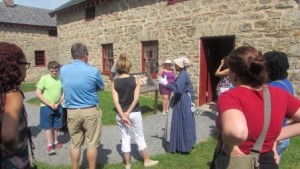Today marks the 99th anniversary of the National Park Service(NPS). Prior to the establishment of the agency in 1916, national parks and national monuments, such as Yellowstone, were individually managed. After a publicity campaign pushing for the establishment of one governing agency, President Woodrow Wilson signed the National Park Service Organic Act to create an agency whose goal is “to conserve the scenery and the natural and historic objects and wildlife therein, and to provide for the enjoyment of the same in such manner and by such means as will leave them unimpaired for the enjoyment of future generations.” It is that latter point that the National Park Service appears to be focusing on in their #FindYourPark campaign to help celebrate their upcoming centennial. It appears that I found my park in Towson, Maryland.
Hampton National Historic Site is an 18th– Century estate that was owned by the Ridgely family from 1745 to 1749, including Charles Ridgely, the 15th Governor of Maryland. Decreased greatly in acreage over the years, the site will still provide you with much to see: the Georgian-style mansion with many of the original furnishings, terraced gardens, and slave quarters amongst other buildings. Standard house tours of the property tell the story of the many generations of Ridgelys who called Hampton their home. But I encourage you to take one of their special tours led by Park Ranger Anokwale Anansesemfo.

“On the Hampton Plantation” and “Servitude In Black and White” are two special tours in which you can explore the property, from the perspective of the many European indentured servants and enslaved Africans and African- Americans who lived and worked at Hampton and helped the Ridgelys acquire their wealth. From the first few minutes of the 90-minute tour, Anokwale’s passion for African-American history is very evident, as well as her penchant for story-telling , which is personified by her chosen name (Anokwale means “truth” in Akan, a Ghanaian language; Anansesemfo means “storyteller”).
During the course of the tour, I learned about Nancy Davis, an enslaved woman who was freed in 1858 but returned to work for Ridgelys until her death in 1908. Davis, who raised three to four generations of Ridgelys, is one of only two servants known to be buried in the Ridgely family cemetery. The intriguing story of Lucy Jackson, a house servant who fled to freedom around 1862, is also shared: in 1866, Lucy obtained a lawyer to sue John Ridgely on her behalf to obtain an extensive list of items that she left behind at Hampton. Some of the items listed included twenty-one dresses, six pairs of lace gloves, and furs and muffs.

It is clear that these stories are intended to change one’s perception of slavery and the lives of the enslaved. Near the conclusion of the tour, Anokwale quoted Frederick Douglass: “Agitate! Agitate! Agitate!” This resounded with me and my training as a public historian. One of the six principles of interpretation laid out by Freeman Tilden, one of the fathers of the NPS, states that “The chief aim of interpretation is not instruction, but provocation.” I do not believe Douglass or Tilden was encouraging physically aggressive forms of agitation or provocation, but more intellectual. Telling Nancy’s or Lucy’s story does not take away from the Ridgelys’ story – it just adds many more layers to it. Entities that engage in public history, like the National Park Service, are at their best when they seek to weave together stories that reflect the tapestry of American history.
The next “On the Hampton Plantation” tour will be held on Sunday, September 6, from 2-3:30pm at Hampton National Historic Site in Towson, Maryland

